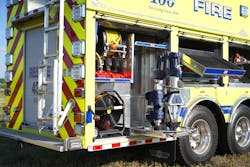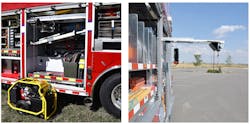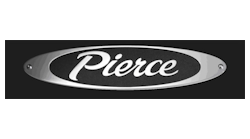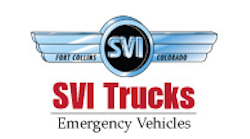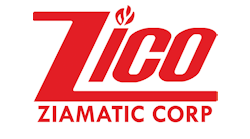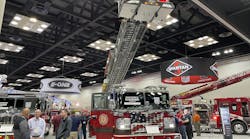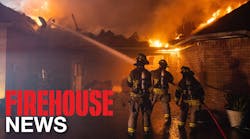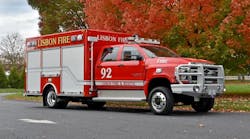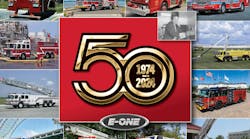The fire service has evolved in response to ever-changing emergencies. Not only have fires themselves become more complex, but the roles that are assigned to firefighters have multiplied.
High-angle and confined-space rescue, swiftwater operations, vehicle extrication and hazmat all have become common concerns. Emergency medical responses now make up the majority of calls in many jurisdictions.
All of these undertakings require not only additional training but specialized equipment, too. To be readily available for instant on-scene use, these tools must be safely and securely stored and transported in an organized manner.
Up until the mid-1950s, most, if not all, inventory either was carried on the running boards or stashed in the booster well of department engines and ladders. True, some specially designed rigs existed, but, overall, compartments were a rarity. Today, apparatus are designed with operational needs in mind.
The bulk of purpose-specific gear typically is carried by heavy rescue vehicles. Although these apparatus might be known locally as Squads or Equipment Trucks, their purpose is clear: They are toolboxes on wheels. From their humble beginnings as panel trucks and delivery vans, they now sport generators, winches, booms, cascade systems, light towers and myriad other mechanical equipment and systems. Some heavy rescues require tandem axles to support their weight and have grown in length so as to be comparable in size to rear-mount aerials. Tractor-drawn varieties even exist.
Delivery and deployment
With new construction, the process of obtaining a heavy rescue begins with inventorying tools and ensuring design of an apparatus that’s suited to the task of delivery and deployment.
Mike Morstatt, who is ex-chief of the Silver Lake, NY, Fire District and who chaired the department’s apparatus committee, shared the experiences that were involved in specifying the department’s Ferrara heavy rescue, which replaced a 25-year-old unit.
“Your cab and chassis are where you have to start,” Morstatt tells Firehouse Magazine. “We weighed our fully loaded existing rig, and that prompted us to opt for a tandem-axle chassis with a full-length double-frame rail.
“Obviously, tool mounting is a priority, especially in a rescue,” he continues. “When you are designing a fire truck, many departments schedule three factory visits. We added a fourth, specifically to focus on mounting tools. This gave us three full days at the factory, and it took every bit of three days to accomplish.”
His advice to others is to be very specific as to make, model number and dimension of tools, to be incorporated into your specs, and have a contingency in your bid to address these costs.
An integral part of the process is the design and location of the heavy rescue compartments themselves. According to Bill Proft, who is the business unit director of rescue products for Pierce Manufacturing, the type of doors that shield compartments is a factor. “There are pros and cons to compartment door styles. Roll-up doors provide the benefit of allowing for a completely ‘wide open’ compartment. Access to equipment is simple and easy, because there are no doors on either side of the compartment. However, space is required for the ‘roll’ of the door and the mechanism at the top of the compartment. This requires approximately 12–14 inches in height and depth by the width of the door that can’t be used for storage.
“Hinged doors don’t take up any of the compartment storage space,” he adds. “However, when open, they block visibility along the length of the truck, which can be problematic on the street side.”
Adequate compartment illumination helps in finding the right tool and in on-scene safety for members.
Mike Mildner, who is rescue specialist for E-ONE, offers, “Departments are experimenting with red or blue lighting in compartments for less harsh ‘eye flash’ to operators over crisp white lighting on scene. This is utilized as a safety measure, so operators don’t step away from the truck into a darker surrounding, with a longer need to allow for their eyes to adjust.”
Many firefighting tools are heavy. Some of them are sharp. Others are bulky in both size and shape. Power tools use a variety of energy sources. Of course, there are tools that operate in conjunction with other devices to function as a system. No matter which of these, it isn’t uncommon for them to be used a good distance from the apparatus, which requires preplanning by members on how to best get them where they are needed.
When Ron Weinmeister, who is president of SVI Trucks, spoke to us about his experience with fire departments’ heavy rescue needs and wants, he shed light on how to intelligently manage tools. “You can double your storage capability if you store your tools properly as opposed to just laying things on the compartment floor. Consider purchasing slide tray and slide-out tool boards during the spec process.”
Clay Horst, who is the general manager of OnScene Solutions, amplifies. “Vertical tool boards are quite popular for maximizing equipment storage.”
He confirms what we’ve heard: interest in battery-powered equipment is on the rise. “We have built many slides for rechargeable battery banks.”
Ziamatic Marketing Manager Ryan Glover tells Firehouse Magazine that he has seen a change in direction over the years in the hundreds of items that his company manufactures. “Tool mounts with cable and pin assemblies aren’t as popular as they once were. Departments are switching to easier strap-based mounts.”
Lazy Susans are used for a variety of purposes, including SCBA cylinders, rescue tools and extinguishers. Transverse compartments handle longer items, as do underbody and top-mounted “coffin” compartments.
Electric winches were mentioned by many of the experts who we contacted for this article, as a means of raising and lowering heavy equipment.
Command posts, rehab, decontamination and other such functions have made their way into the mainstream fire service, each introducing its own set of tools that often are assigned to the heavy rescue apparatus.
For example, the Malaga, NJ, Volunteer Fire Company carries a refrigerator, which replaced the ice chest that was carried on its former unit. According to Chief Anthony Baldosaro, “Members had to report to the station about every three days to remove the melted ice and replace it. The water, towels, blankets and other items were all in the same compartment, which we call the rehab compartment.”
Chief Michael Ryman of the Burtonsville, MD, Volunteer Fire Department (BVFD) shares another user perspective. “Our [heavy rescue] design was based on jurisdictional requirements and predicated on the inventory we knew that we were going to carry.”
One of the things that the department added to the vehicle was hydraulic lifting cylinders. A significant portion of Washington, D.C.’s Metrorail train system falls within the department’s response area.
“Adding six 50-ton cylinders [which can lift rail cars in the event of an accident] and associated hoses and controls was a significant consideration of space,” Ryman explains.
Also taken into account: The BVFD’s strut inventory easily has doubled in recent months.
“We took advantage of the transverse space, which holds 98 percent of this equipment,” BVFD’s Chief says about how this worked into design. “Two longer pieces that we use less frequently but need to have are on the roof.
“As we worked through the ergonomics of the design of this unit, we tried to address getting the equipment off,” Ryman continues. “The things that we use constantly are low to the ground and easy to access. We focused on the principle, ‘If I have to get to a piece of equipment, I shouldn’t have to move another piece to get to it.’”
Tool mounting
There likely are as many ways to mount tools and equipment as there are types of tools and equipment. In fact, strapping a stuffed mascot to the grill was mentioned amusingly as a unique challenge that was indicated by an apparatus committee by Ziamatic’s Glover.
Although apparatus manufacturers and specialty companies that support them have the expertise to meet even obscure requests, it’s up to the local jurisdiction to best design heavy rescue compartment layout.
Every department chief who we interviewed for this article stressed the need for planning and closely monitoring the mounting processes. As summed up by Ryman, “We had a member literally standing next to fabricators 75 percent of the time [that the BVFD’s heavy rescue was being outfitted]. We maximized space and ensured equipment was mounted in an efficient way. Using the conferencing technology that we have available today allowed immediate video contact with other members of the team, when needed, to show them exactly what was going on.”
It shouldn’t be construed that the solutions that are discussed are limited to new apparatus. Regardless of a rig’s age, intelligent placement and mounting of tools saves time on the fireground and, in the end, saves time saving lives.
